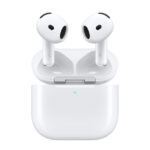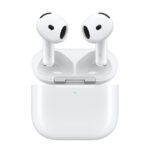The 2025 camera landscape is defined by two converging trends: unprecedented image quality at every price point and the rapid spread of AI-powered features that do everything from horizon leveling to real-time background blur. Whether you’re filming cinematic shorts or family vacations, today’s models offer 10-bit color, in-body stabilization, and cloud-ready connectivity that were professional-only perks just a few years ago.
In this guide you’ll find our rigorously selected favorites—ranked, tabled, and ready to meet a wide range of budgets and shooting styles—followed by a deep dive into the tech that actually matters when you press record.
| Rank | Product | Price |
|---|---|---|
| 1 | Kimire Video Camera | Click to Check |
| 2 | MURAUX 8K Video Camera | Click to Check |
| 3 | DJI Osmo Pocket 3 Creator Combo | Click to Check |
| 4 | OLESIT Full HD Camcorder | Click to Check |
| 5 | VETEK Video Camera | Click to Check |
| 6 | Sony ZV-1F Vlog Camera | Click to Check |
| 7 | DINGETU 4K Vlogging Camera | Click to Check |
| 8 | YIGLLO 4K Digital Camera | Click to Check |
| 9 | Panasonic LUMIX FZ80D | Click to Check |
| 10 | Canon EOS Rebel T7 DSLR Camera | Click to Check |
Why These Cameras Made the List
- Budget-Friendly Starters – Kimire, VETEK, and OLESIT prove you can spend well under $200 and still get flip screens, dual batteries, and webcam modes for streaming.
- Resolution Pioneers – MURAUX’s headline-grabbing 8 K spec shows how far entry-level resolution has leapt, while DINGETU pushes crisp 4 K with night-vision flair.
- Creator-First Tools – DJI Osmo Pocket 3 and Sony ZV-1F pack 1-inch sensors, advanced face/eye tracking, and log profiles into ultra-portable bodies that simplify solo shooting.
- Zoom & Versatility Champs – Panasonic’s 60× optic on the FZ80D captures wildlife half a football field away, and Canon’s Rebel T7 introduces lens-swapping flexibility without overwhelming novices.
2025 Feature Highlights You Should Know
- AI Autofocus & Framing: Mid-tier models now recognize eyes, pets, and vehicles, dynamically reframing to keep subjects centered—ideal for vloggers who shoot alone.
- 10-Bit Log Recording: Once reserved for cinema rigs, flat color-rich profiles are now standard on sub-$1,000 cameras, giving editors headroom for dramatic grading.
- HDMI 2.1 & USB-C 3.2: Faster ports enable 4 K/120 fps clean output to capture cards and SSDs, making live-streaming and long-form recording more reliable.
- Next-Gen Stabilization: Hybrid systems blend gyro data with optical lens shifts—some kits even auto-detect walking cadence to smooth vertical bounce.
- Eco-Smart Power: GaN chargers and higher-density Li-ion packs halve charge times and extend runtimes; many models now support PD-powered filming for unlimited shoots.
Choosing the Right Video Camera
| Spec | Why It Matters | 2025 Benchmark |
|---|---|---|
| Resolution | Determines detail; 4 K future-proofs footage, 8 K enables deep cropping | 4 K/60 p minimum, 10-bit log preferred |
| Sensor Size | Bigger sensors handle low light and create cinematic depth | 1-inch for compacts, APS-C or full-frame for interchangeable-lens models |
| Stabilization | Keeps handheld shots usable without a gimbal | 5-axis in-body plus electronic gyro compensation |
| Autofocus System | Eye and subject detection save takes | Dual-pixel or phase-hybrid with AI tracking |
| Connectivity | Streamlines workflow and sharing | Wi-Fi 6E, Bluetooth LE, HDMI 2.1, USB-C PD |
| Battery & Media | Dictate shoot length and backup strategy | 2+ hours on one pack; CFexpress Type B or V90 SD |
Camera Types Explained
- Pocket Gimbals (e.g., DJI Osmo Pocket 3) – Best for travel vloggers who want buttery 4 K/120 fps without extra rigs.
- Budget Camcorders (Kimire, OLESIT) – Simple menus, long battery life, and flip screens for under $150—great for family archives.
- 8 K Value Leaders (MURAUX) – Push creative flexibility; down-sampled 4 K looks sharper, and you can extract high-res stills.
- High-Zoom Bridge Cameras (Panasonic FZ80D) – Combine DSLR ergonomics with massive zoom ranges for wildlife, airshows, and sports.
- DSLR & Mirrorless Systems (Canon Rebel T7) – Interchangeable lenses unlock pro-level depth of field and creative specialty optics.
Pro Tips for Better Footage in 2025
- Leverage AI Editing – Pair camera gyroscopic data with software like DJI LightCut or Sony Catalyst for post-stabilization that rivals Steadicams.
- Shoot Flat, Grade Later – Log or HLG profiles capture more dynamic range; apply LUTs in post for a polished look without crushing highlights.
- Future-Proof Storage – Invest in UHS-II V90 or CFexpress cards; 10-bit 4 K/60 p eats 45-60 GB per hour.
- Master Audio Early – Even a $50 lav mic will outperform built-ins; monitor levels on-headphones to catch wind rumble or clipping.
- Exploit Firmware Updates – Manufacturers now roll out autofocus tweaks and codec upgrades regularly; a free update can add years of life to your gear.
Armed with the specs that count and a clear view of the market’s strongest contenders, you can match the right camera to your creative ambitions—whether that’s cinematic documentaries, viral short-form content, or simply capturing milestones with unprecedented clarity.
Best Video Cameras for 2025
Finding the right video camera can transform how you capture life’s moments. Our team has tested the latest models to identify standout options for every skill level and budget. These top picks offer exceptional image quality, user-friendly features, and reliability for content creators, filmmakers, and casual users alike.
Kimire Video Camera

The Kimire Video Camera offers decent features at an affordable price point for casual users seeking basic recording capabilities without breaking the bank.
Pros
- Includes two rechargeable batteries for extended recording time
- Functions as a webcam when connected to a computer
- Features 270-degree rotatable LCD screen for flexible shooting angles
Cons
- Limited to 15fps at 1080p resolution, below standard for smooth video
- Requires separate purchase of SD card (not included)
- Image quality falls short compared to similarly priced smartphones
This compact camcorder delivers several practical features for beginners or casual videographers. The device captures 1080p video (though only at 15 frames per second) and 24MP still images. Its 3-inch LCD screen rotates 270 degrees, helping users frame shots from various angles.
Battery life stands out as one of the Kimire’s strengths. The package includes two rechargeable batteries that provide approximately 60-90 minutes of recording time each. The camera also supports recording while charging, making it suitable for longer sessions when near a power source.
The webcam functionality adds versatility for those who need video conferencing capabilities. Users can connect the camera to a computer via USB and use it for video calls. Additional features include 16x digital zoom, anti-shake technology, and a pause function that allows recording to resume without creating multiple files. While the camera doesn’t match professional equipment, it serves as a budget-friendly option for family events, YouTube beginners, or children interested in video production.
MURAUX 8K Video Camera
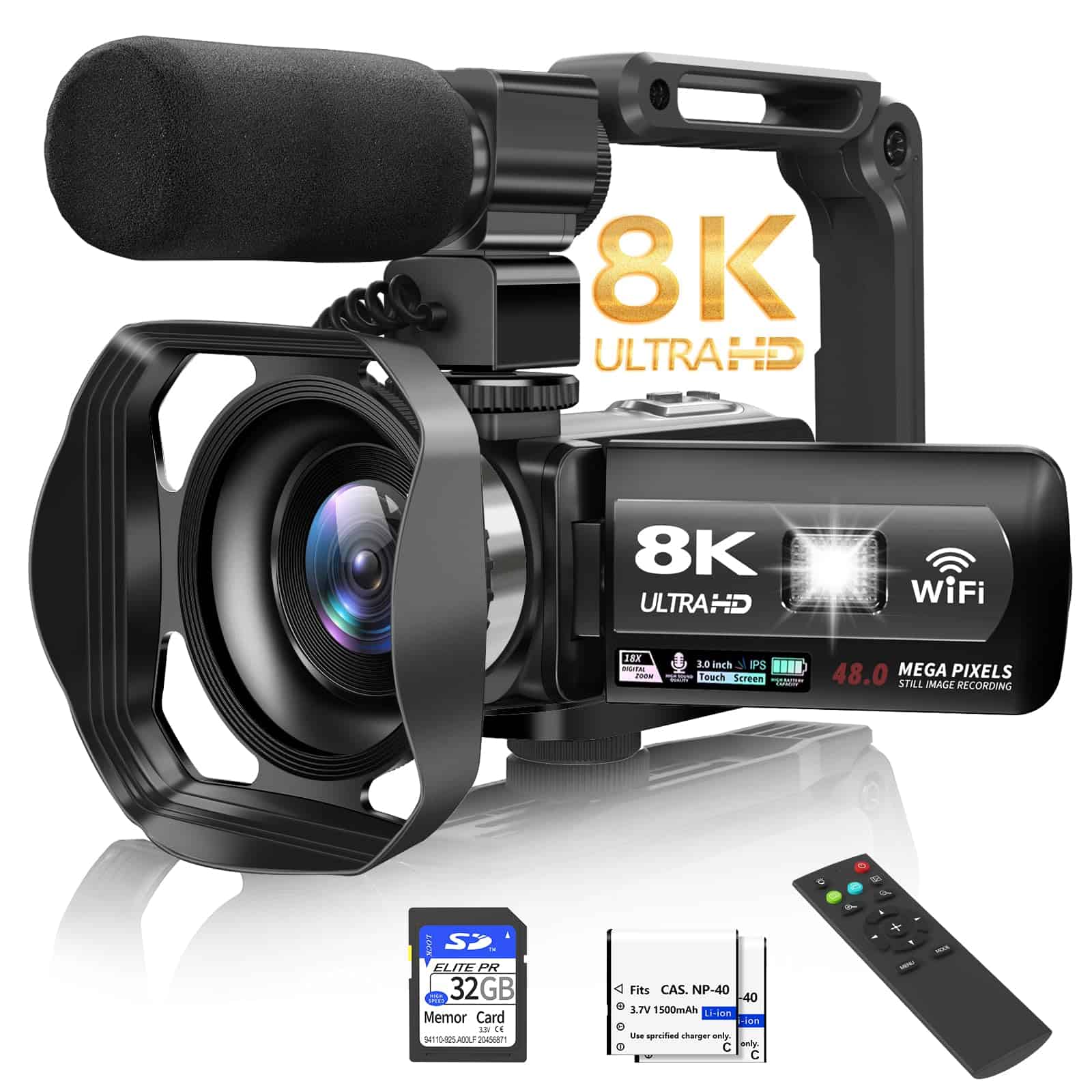
This feature-rich 8K camcorder offers impressive specifications for beginners while having some notable limitations in focus capability.
Pros
- High-resolution 8K video and 48MP photo capability
- Versatile 3-inch rotating touchscreen with night vision
- Complete accessory package with two batteries and microphone
Cons
- Fixed focus with 4+ meter optimal shooting distance
- Limited to 15FPS at 8K resolution
- No manual focus adjustment options
The MURAUX 8K Video Camera combines several desirable features in a compact, lightweight package weighing under a pound. Its ability to record 8K video at 15FPS and capture 48MP photos makes it suitable for beginners looking to create content for YouTube or social media. The 3-inch IPS touchscreen rotates 270 degrees, allowing users to frame shots from multiple angles.
Connection options add to this camera’s versatility. Users can connect via WiFi to transfer files to mobile devices, making content sharing straightforward. The webcam functionality turns this device into a high-quality option for video calls. These connectivity features extend the camera’s usefulness beyond basic recording.
Night shooting becomes possible with the built-in infrared night vision and fill light. The 18x digital zoom helps with distant subjects, though image quality may degrade at maximum zoom as with most digital zoom systems. Beginners will appreciate included accessories like a microphone, lens hood, stabilizer, and remote control – eliminating the need for immediate additional purchases.
The fixed focus system represents this camera’s main limitation. With an optimal shooting distance of over 4 meters, it’s better suited for landscapes and group shots than close-up work. Content creators needing precise focus control should consider this limitation carefully before purchasing.
DJI Osmo Pocket 3 Creator Combo

The DJI Osmo Pocket 3 Creator Combo offers content creators a powerful, pocket-sized solution with its impressive 1-inch sensor, stabilization capabilities, and comprehensive audio options.
Pros
- Exceptional 4K/120fps video quality with a larger 1-inch sensor
- Versatile 2-inch rotating touchscreen for both vertical and horizontal shooting
- Advanced 3-axis stabilization eliminates shakiness during movement
Cons
- Requires separate microSD card purchase for storage
- Battery charger sold separately (DJI 30W USB-C charger recommended)
- Limited for photography compared to dedicated cameras
The Osmo Pocket 3 Creator Combo represents a significant upgrade from previous pocket gimbals. Its 1-inch CMOS sensor captures stunning footage even in challenging lighting conditions, making it ideal for travel vloggers and content creators. The 2-inch touchscreen rotates seamlessly between horizontal and vertical orientations, adapting to different social media platforms without compromising quality.
Video quality stands out with 4K recording at 120fps in slow-motion mode. Users can capture smooth footage while walking, running, or even dancing thanks to the 3-axis mechanical stabilization. ActiveTrack 6.0 technology keeps subjects centered in the frame automatically, which proves invaluable for solo creators who need to film themselves.
Audio capabilities receive a significant boost with the included DJI Mic 2 Transmitter. This wireless microphone enhances sound quality dramatically compared to built-in options, perfect for interviews or narration in noisy environments. The Creator Combo also includes a battery handle that extends recording time, making it suitable for day-long shooting sessions.
Portability remains a key strength of this device. Despite its powerful features, the Osmo Pocket 3 maintains a compact form factor that easily fits in pockets or small bags. Fast charging capabilities (80% in 16 minutes) ensure minimal downtime during shooting days. For content creators seeking professional-quality video without carrying bulky equipment, this combo offers an efficient solution.
OLESIT Full HD Camcorder

This budget-friendly 1080p camcorder offers decent video quality, long battery life, and helpful features that make it a good choice for beginners or casual videographers.
Pros
- Includes 32GB SD card and 150-minute battery life
- Built-in fill light for low-light recording
- Can function as a webcam for streaming
Cons
- Limited to 1080p/25fps video quality
- Audio quality may require external microphone
- Digital zoom rather than optical zoom
The OLESIT camcorder delivers solid performance for its price point. With 1080p recording capabilities and a 16x digital zoom, it handles basic video needs adequately. The 3-inch IPS screen provides clear visibility when framing shots, while the included remote control makes self-recording and group shots much easier.
Battery life stands out as a major advantage. The 1500mAh rechargeable battery delivers up to 150 minutes of continuous recording time. This extended capacity eliminates the frustration of missing important moments due to power issues. The camcorder can also record while charging, adding extra flexibility for longer shooting sessions.
The device includes several features typically found in more expensive models. Its built-in fill light helps with recording in dim environments. The webcam functionality lets users connect to a computer for live streaming on platforms like YouTube or Skype. For beginners, the easy-to-navigate controls and lightweight design (about 1 pound) make this camera accessible right out of the box.
Storage options are generous with support for SD cards up to 256GB. The package includes a 32GB card to get started immediately. Users will appreciate additional features like face recognition, time shooting, and pause function. While serious videographers might want more advanced options, this OLESIT camcorder offers good value for family events, travel videos, and basic vlogging needs.
VETEK Video Camera

This affordable 1080p video camera offers impressive features for beginners and casual users seeking quality video recording without breaking the bank.
Pros
- Night vision capability with infrared technology
- Versatile functions including webcam mode and remote control
- User-friendly with pause function and 18x digital zoom
Cons
- Limited to 1080p resolution (not 4K)
- External accessories like microphones sold separately
- Battery life may be insufficient for extended recording sessions
The VETEK Video Camera delivers solid performance with its Full HD 1080p recording and 24MP photo capability. Users will appreciate the 3-inch rotatable LCD screen that makes framing shots from different angles much easier. Its compact size (about 5 inches long and weighing just over a pound) ensures the camera remains portable for travel vlogging or family events.
Night vision functionality sets this camera apart from many competitors in its price range. The infrared technology allows for clear black and white video recording in low-light environments, making it suitable for evening events or nature observation. The included remote control enhances this feature, letting users set up the camera on its tripod mount for hands-free operation.
Connection options expand the camera’s versatility significantly. Users can easily transfer files to computers via USB or use the device as a webcam for video calls and streaming. The pause function prevents creating multiple files during recording sessions, simplifying the editing process. While serious videographers might want more advanced features, this camera represents excellent value for families, young content creators, or anyone needing a reliable video recording device for everyday use.
Sony ZV-1F Vlog Camera

The Sony ZV-1F offers an impressive blend of professional features and user-friendly operation that makes it an ideal choice for content creators seeking quality video without the complexity of professional equipment.
Pros
- Ultra-wide 20mm lens captures everything even at arm’s length
- Large 1-inch sensor delivers excellent low-light performance
- Eye-tracking autofocus keeps subjects sharp without manual adjustments
Cons
- Battery life could be better for extended shooting sessions
- Photo quality doesn’t match its exceptional video capabilities
- Price point may be steep for beginners
This compact powerhouse provides vloggers with a dedicated tool that addresses common pain points in content creation. The side-articulating touchscreen makes self-recording intuitive, allowing creators to frame shots perfectly without guesswork. Its lightweight design at just 9 ounces makes it easy to carry for extended periods.
Video quality stands out as the ZV-1F’s strongest feature. The combination of the large 1-inch sensor and F2 lens creates professional-looking footage with pleasing background blur. Sony’s implementation of Eye-AF technology ensures subjects remain in focus regardless of movement, eliminating the frustration of ruined takes due to focus hunting.
Audio performance deserves special recognition. The built-in 3-capsule microphone with included windscreen delivers clear voice capture even in challenging conditions. This reduces the need for external microphones in many shooting situations. The product’s portability and simplified controls make it accessible for novices while offering enough quality to satisfy more experienced creators.
Many users appreciate the product’s thoughtful design choices specifically targeting content creators. The background defocus button instantly creates professional-looking bokeh effects without requiring technical knowledge. For those upgrading from smartphone videography, the ZV-1F represents a significant step up in quality while maintaining an approachable learning curve.
DINGETU 4K Vlogging Camera

The DINGETU 4K camcorder delivers impressive features at an accessible price point, making it an excellent choice for amateur videographers seeking quality video recording capabilities.
Pros
- 4K resolution with 44MP image quality
- Night vision capability for low-light filming
- Includes two batteries and external microphone
Cons
- 18X zoom is digital rather than optical
- Limited to 75 minutes of recording time
- Designed for amateurs, not professional production
This compact camcorder offers 4K/30FPS video recording with 44MP photo capability, providing crisp visuals for family gatherings, travel adventures, or content creation. The 3-inch IPS screen rotates 270 degrees, giving users flexibility when framing shots or recording themselves for vlogs.
Battery life extends to approximately 75 minutes of continuous 4K recording with the included dual batteries. The package also contains an external microphone that significantly improves audio quality compared to built-in options. For convenience, a remote control allows users to operate the camera from a distance.
Versatility stands out as a key strength with features like webcam functionality, pause recording, time-lapse, and slow motion. The infrared night vision capability enables filming in dark environments, expanding creative opportunities beyond daylight hours. Users will appreciate the included 32GB SD card, though the device supports cards up to 256GB for extended recording sessions.
The lightweight design makes this camera highly portable for everyday use. While not targeted at professional videographers, hobbyists and content creators will find sufficient quality and features to capture memorable moments. The easy-to-navigate interface suits beginners who want quality video without complex settings.
YIGLLO 4K Digital Camera

The YIGLLO 4K Digital Camera offers impressive functionality for content creators and casual photographers seeking a budget-friendly option with surprisingly robust features.
Pros
- 48MP photos and 4K video with auto-focus capability
- 180° flip screen ideal for vlogging and self-recording
- Includes two batteries, charging stand, and 32GB SD card
Cons
- Digital-only zoom limits professional applications
- Not water-resistant for outdoor adventures
- Image quality diminishes in low-light conditions
This compact camera combines accessibility with advanced features that outperform its price point. The 3-inch flip screen rotates 180 degrees, making it perfect for vloggers who need to frame themselves while recording. Built-in flash functionality helps compensate for challenging lighting situations, though results vary.
Auto-focus technology delivers reliable performance even in bright environments, allowing users to capture clear, well-defined subjects. The camera’s 16x digital zoom provides reasonable flexibility for framing shots, though image quality naturally decreases at maximum zoom. Battery life proves adequate for casual shooting sessions, and the included charging stand makes it convenient to keep a spare battery ready.
Connectivity options enhance the camera’s versatility considerably. Users can employ it as a webcam by connecting via USB and selecting the appropriate mode. HDMI output enables playback on larger screens, expanding viewing options beyond the built-in LCD. The hot shoe mount accommodates external accessories like microphones or additional lighting, addressing some limitations of the built-in hardware.
For beginners or content creators seeking an affordable entry point, this camera delivers impressive value. Special shooting modes including time-lapse, slow motion, and motion detection add creative possibilities without overwhelming complexity. While serious photographers might desire optical zoom and better low-light performance, the YIGLLO successfully balances features and affordability for everyday users.
Panasonic LUMIX FZ80D
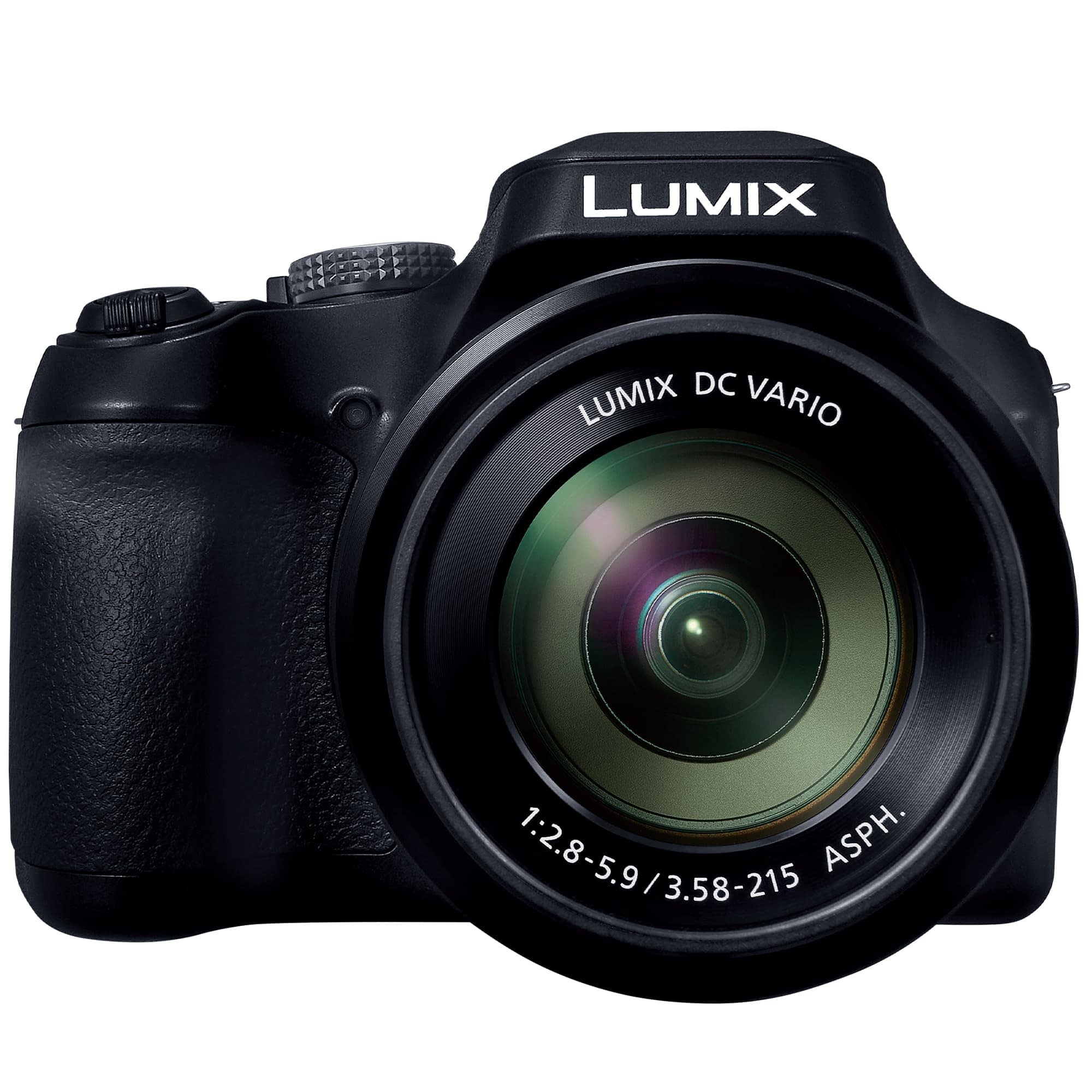
The LUMIX FZ80D offers exceptional versatility with its impressive zoom range and 4K capabilities, making it an excellent choice for amateur photographers seeking a feature-rich point-and-shoot camera.
Pros
- Powerful 60x zoom (20-1200mm) captures both wide landscapes and distant details
- 4K video recording with ability to extract 8MP still images
- Post-Focus feature allows focusing adjustment after taking the shot
Cons
- Image quality degrades at higher ISO settings
- Relatively bulky compared to pocket-sized compact cameras
- Battery life could be better for extended shooting sessions
This versatile camera combines the convenience of a point-and-shoot with impressive zoom capabilities. The 20-1200mm equivalent lens range lets users capture everything from sweeping landscapes to wildlife from a distance. For close-up photography enthusiasts, the macro mode focusing at just 1cm opens up a world of detailed possibilities.
Video performance stands out with 4K recording that delivers four times the resolution of standard Full HD. The ability to extract 8-megapixel still images from 4K footage proves particularly useful for capturing the perfect moment in action sequences. Panasonic’s POWER O.I.S. stabilization system effectively minimizes blur even at extreme zoom levels.
The camera features a clear 2,360K-dot electronic viewfinder with 0.74x magnification, providing excellent visibility even in bright sunlight. Its intuitive Post-Focus function solves a common photography problem by allowing users to select the focus point after taking the shot. While not the smallest option available, the FZ80D strikes a good balance between portability and functionality for travel photography, nature excursions, and family events.
Canon EOS Rebel T7 DSLR Camera
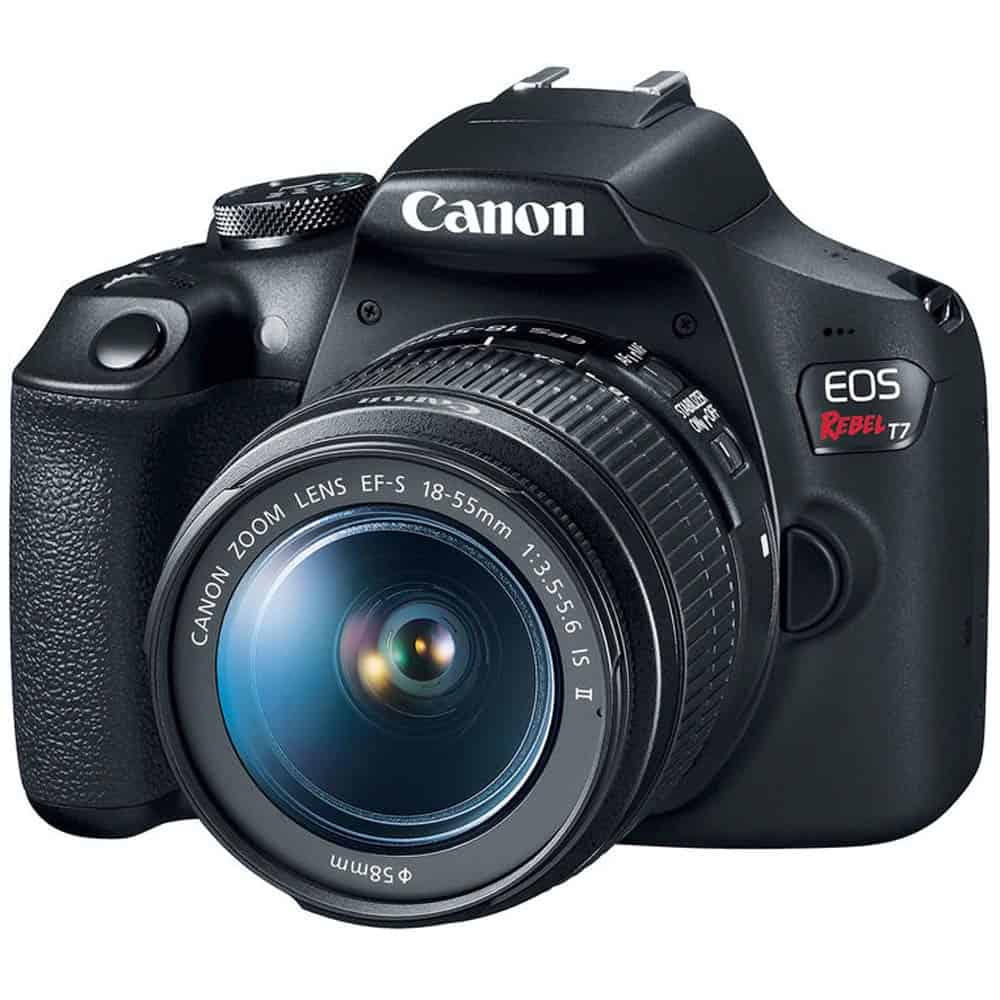
The Canon EOS Rebel T7 is an excellent entry-level DSLR for photography beginners seeking professional-quality images without overwhelming complexity or cost.
Pros
- 24.1 Megapixel CMOS sensor captures detailed, high-quality images
- Built-in Wi-Fi for easy photo sharing and remote shooting
- Simple, user-friendly interface ideal for photography newcomers
Cons
- Limited continuous shooting speed of only 3 fps
- Fixed LCD screen lacks touch capabilities
- Autofocus system with only 9 points is basic compared to newer models
This beginner-friendly DSLR package includes everything needed to start a photography journey. The camera features a substantial 24.1 Megapixel APS-C sensor that performs admirably even in challenging lighting conditions with its ISO range of 100-6400 (expandable to 12800). Its optical viewfinder provides approximately 95% coverage of the scene, helping photographers frame their shots with precision.
Canon equipped the Rebel T7 with built-in Wi-Fi and NFC technology, allowing for seamless photo sharing and remote camera control through compatible devices. This connectivity feature proves particularly valuable for social media enthusiasts or those wanting to transfer images without removing the memory card. The included 18-55mm lens offers versatile focal length for everyday photography, from landscapes to portraits.
Battery life extends to approximately 500 photos per charge, sufficient for day-long shooting sessions. The camera records Full HD 1080p video, making it suitable for capturing both still images and video content. Despite its entry-level positioning, the Rebel T7 delivers impressive image quality that will satisfy most beginners and enthusiasts. Its lightweight design (just 1.04 pounds) makes it comfortable to carry during extended photography outings.
Buying Guide
Selecting the right video camera requires careful consideration of several key features. This guide will help you make an informed decision based on your specific needs.
Resolution
Resolution determines image quality. Most modern cameras offer at least Full HD (1080p), while 4K provides sharper images with more detail.
| Resolution | Best Use |
|---|---|
| 720p | Basic video recording |
| 1080p | Standard high-definition |
| 4K | Professional-quality footage |
| 8K | Cinema-grade production |
Sensor Size
Larger sensors capture more light, resulting in better image quality, especially in low-light conditions. Full-frame sensors offer superior performance but come at a higher price point.
Lens Options
Fixed lens cameras are convenient for beginners. Interchangeable lens systems provide flexibility but require additional investment.
Storage and Battery Life
Consider how much footage you plan to shoot between charges. Most cameras use SD cards for storage, with capacity ranging from 32GB to 512GB.
Image Stabilization
This feature reduces camera shake, producing smoother footage. Optical stabilization generally outperforms digital methods.
Audio Quality
Built-in microphones vary widely in quality. Cameras with external microphone inputs allow for better sound recording.
Connectivity
Look for cameras with HDMI outputs, USB ports, and wireless capabilities like Wi-Fi and Bluetooth for easier file transfers.
Weather Resistance
If shooting outdoors frequently, weather-sealed cameras provide protection against dust and moisture.
Consider your budget and intended use when weighing these features. A camera for family videos has different requirements than one for professional filmmaking.



